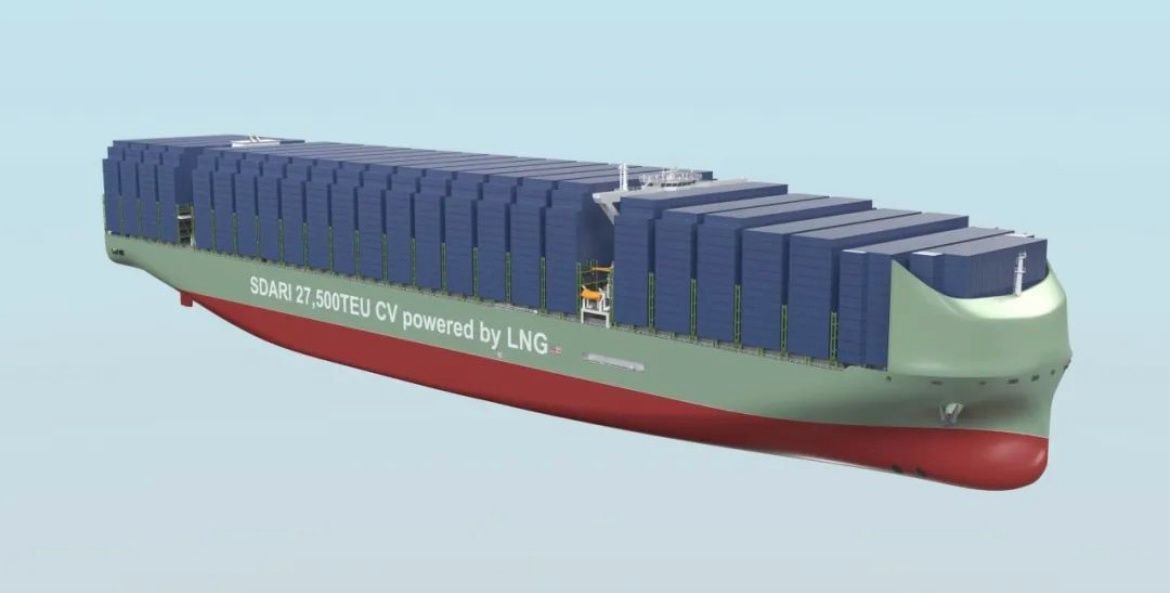Looking ahead, how will the trend towards larger ships and new fuels continue to develop?
On September 3, 2024, the Shanghai Ship Design and Research Institute, part of the China State Shipbuilding Corporation (CSSC), obtained Approval in Principle (AiP) certificates for five new ship designs at the SMM International Maritime Trade Fair held in Hamburg.
These designs include the world’s largest 27,500 TEU LNG dual-fuel container ship, a 20,000 TEU ammonia dual-fuel container ship, a 16,000 TEU LNG dual-fuel container ship, a 103,000 cubic meter Very Large Ethane Carrier (VLEC), and a 93,000 cubic meter Very Large Ammonia Carrier (VLAC).
(Text by Hiro Yamamoto) Photo courtesy of CSSC

Regarding this series of design approvals, Japanese shipping and shipbuilding professionals have expressed a uniform sense of surprise. In particular, the 27,500 TEU ultra-large container ship, with a total length exceeding 400 meters, is expected to pose significant challenges in maneuvering. Moreover, there is astonishment at the extraordinary ambition of Chinese shipyards in their shipbuilding endeavors.
In the past, global maritime stakeholders believed that the size of container ships would reach its limit at around 10,000 TEU. However, ships have continued to grow larger, first to 14,000 TEU, then to 24,000 TEU, and now the 27,500 TEU design has received approval.
Since container ships primarily serve the East-West routes, passing through the Red Sea and the Suez Canal is essential. Currently, due to attacks by Houthi forces, some container ships are taking a detour around the Cape of Good Hope to reach Europe. However, once the Red Sea risks subside in the future, there will come a time when these ultra-large container ships will navigate the Suez Canal. At that point, opinions among maritime professionals are divided on the extent to which operational risks will increase.
〆世界最大の2万7500TEU型、CSSCがSMMでAipを取得した。
SMMハンブルクの一つの到達点。
2024年9月3日、中国船舶工業集団公司(CSSC)の上海船舶研究設計院が設計した5つの新しい船舶デザインが、ハンブルクで開催されたSMM国際海事展において原則承認(AiP)証明書を取得した。
これらのデザインには、世界最大のコンテナ船である27,500 TEUのLNGデュアル燃料船、20,000 TEUのアンモニアデュアル燃料コンテナ船、16,000 TEUのLNGデュアル燃料コンテナ船、103,000立方メートルの超大型エタン運搬船(VLEC)、そして93,000立方メートルの超大型アンモニア運搬船(VLAC)が含まれている。
(Text by Hiro Yamamoto)
Photo courtesy=CSSC
この一連のデザイン認証について、日本の海運、造船関係者は一様に驚きの表情を覚醒内でいる。一ついは2万7500TEU型の超大型コンテナ船は、全長も400㍍を超え、その操船が相当難しくなるであろうこと、さらに中国造船所のその驚異的な建造意欲に対して驚きを隠せない。
世界の海事関係者は過去、コンテナ船の大型化は1万TEUで限界がくると思っていたい。しかし、その後、1万4000TEU、2万4000TEUと大型化が進み、今回、2万7500TEU型が認証を受けたのである。
コンテナ船は、東西航路を主力とするため、紅海、スエズ運河の通航が必須だ。現在はフーシ派の攻撃コンテナ船は喜望峰を迂回して欧州へ航海する。しかし、今後、紅海リスクが終われば、スエズ運河をこの超大型コンテナ船が通航する時がくる。その際、運航リスクはどの程度に増加なるのか、現時点で、海事関係者の間で意見は分かれている。
SNSや中国海事専門紙によると、今回、CSSCが開発した27,500 TEU LNGデュアル燃料コンテナ船「GREEN SEALION 27500」は、コンテナ容量の世界記録を樹立し、海上物流の効率性において大きな飛躍を遂げることになる。最適化された船体設計とLNGデュアル燃料推進により、IMOの第3段階の炭素削減要件を満たし、陸電を使用して港内でのゼロ排出を達成できる。
20,000 TEUのアンモニアデュアル燃料コンテナ船「GREEN SEALION 20000」は、CSSCの子会社の最先端技術を取り入れた次世代の船だ。革新的なアンモニア燃料システムと先進的な省エネルギーデザインを備え、この船は環境に優しい海上輸送の再定義を目指す。
16,000 TEUのLNGデュアル燃料コンテナ船「GREEN SEALION 16000」は、エネルギー効率と環境への影響の削減を両立する。ワイドボディ設計により貨物容量が増加し、バラスト水の使用が削減され、地球規模の海運における持続可能性をさらに支援する。
93,000立方メートルのVLACおよび103,000立方メートルのVLECは、液化ガス輸送における画期的な船舶である。これらの船舶は、LPG、アンモニア、エタンを輸送するために、最先端の推進システムと高度なエネルギー効率技術を備えている。
これらの画期的な成果は、CSSCがグリーンテクノロジーの先駆者として、持続可能な海運をリードするというコミットメントを強調している。
今後、船舶の大型化、新燃料はどのように進んでいくのだろうか。
